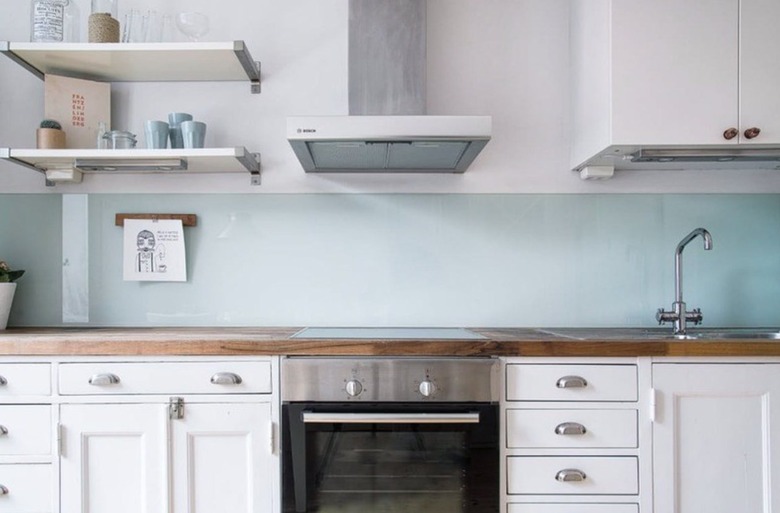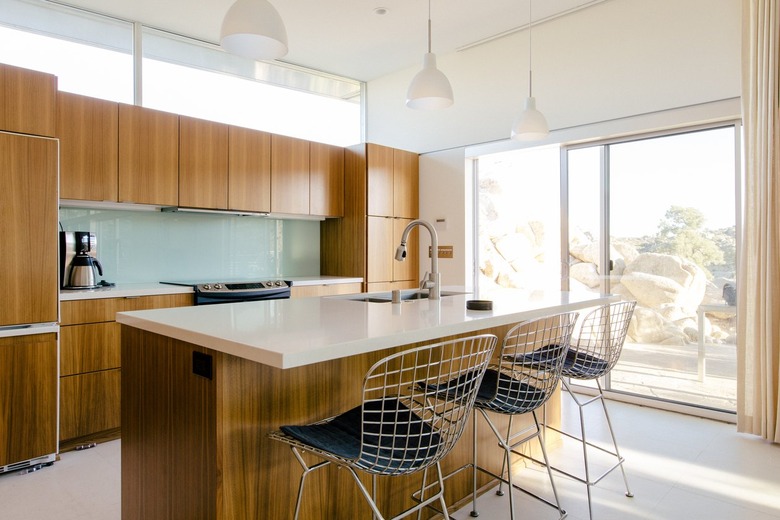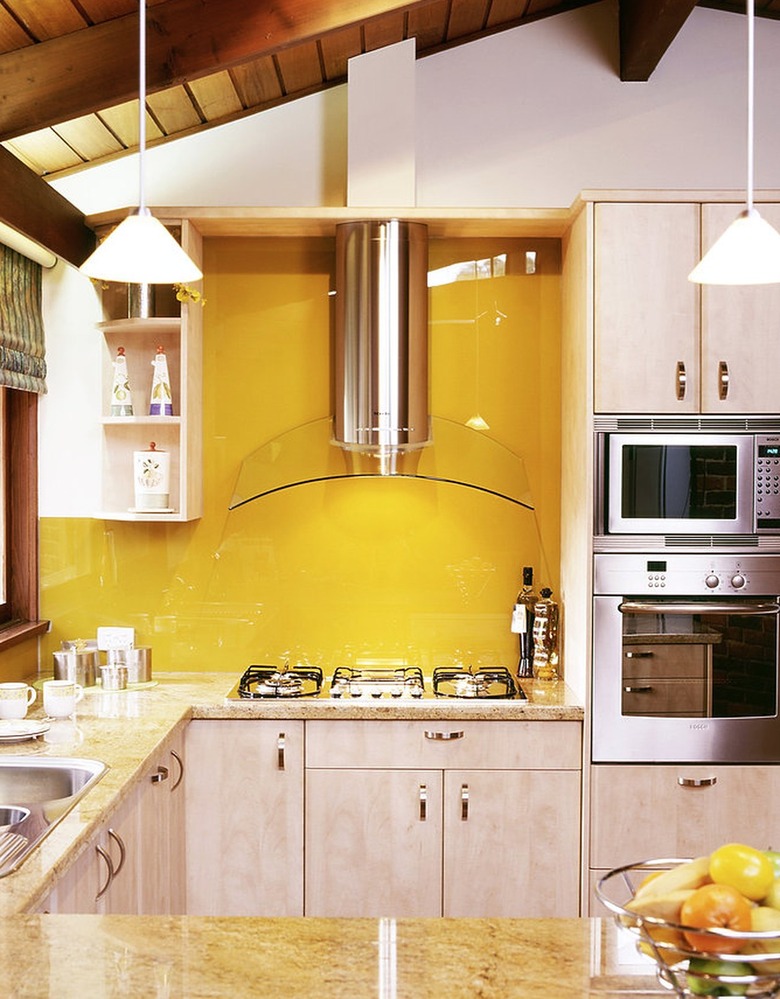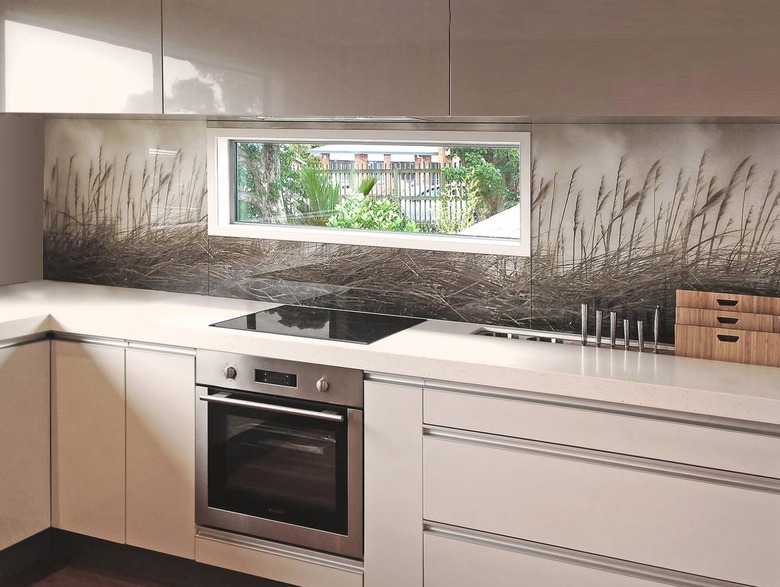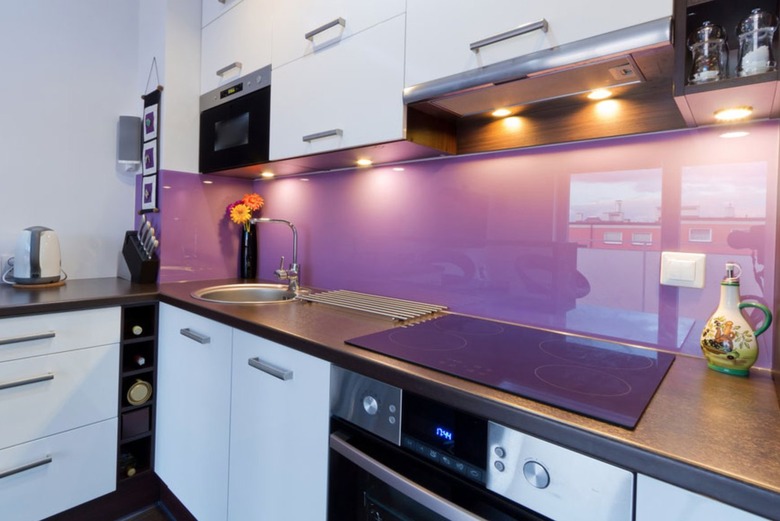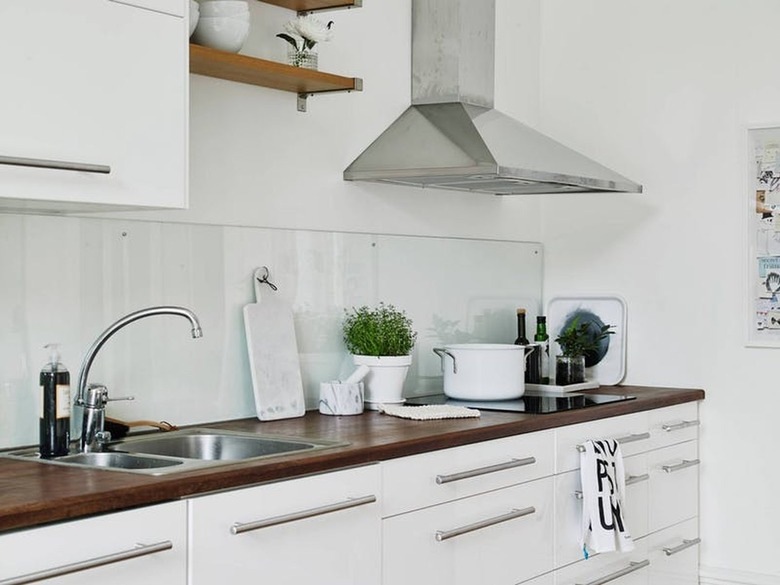Glass Sheet Kitchen Backsplashes: Here's What You Need To Know
When it comes to eye-catching, contemporary kitchen design, glass backsplashes are becoming more and more popular because the material offers an easy-to-clean and chic focal point that can actually cost less than many of the wall tile alternatives. Glass tends to brighten any cook space, and unlike some materials, it isn't flammable, so it can be installed safely behind the stove.
The main drawback of a glass sheet kitchen backsplash for the DIY homeowner is that you typically can't make it yourself (unless your workshop happens to include precision glass-working equipment). You can have this glass wall accent custom made and mount it yourself, but even installation is a tricky job that's best left to pros. Yes, you'll probably need to pay for a skilled contractor, but that may not be a deal-breaker after you consider the benefits of solid glass over other backsplash materials. Here's everything else you need to know before going the glass route in your kitchen.
It's a solid glass backsplash, not glass tiles.
It's a solid glass backsplash, not glass tiles.
A glass sheet backsplash is a solid piece of glass that, like a window, covers the wall behind your kitchen stove and counter. And although you can't see through to the outdoors, it provides all the same reflectivity of a window. A glass backsplash may be clear, frosted, or painted on the back — its versatility is unmatched. If you have existing kitchen wallpaper that you love, covering it with a matte glass backsplash is a great way to preserve the design.
In contrast to glass kitchen backsplash tiles, a glass sheet backsplash has no pattern or grout lines to keep clean. Instead, it provides a solid, hygienic surface that is as easy to degunk as stone countertops. There are some styles that are etched or even mirrored, but for the most part, the surface is usually consistent. And the reflectivity can have a noticeable effect on spatial perception. Moreover, it can help bounce light around in a dark space.
In fact, its ability to bring light into a too-dark kitchen is one of the main reasons people choose a solid glass backsplash. When placed in front of a window or strategically used in conjunction with overhead lighting, solid glass magnifies the light in a beneficial, non-invasive way.
Pros and Cons of Glass Backsplashes
Pros and Cons of Glass Backsplashes
Before you commit to a glass backsplash idea, there are some things to consider. From the cost of materials to installation to upkeep, here are the pros and cons to help you sort out your final interior design decision.
Pros of Glass Backsplashes
- Depending on the size of the area you intend to cover, glass backsplashes are less expensive than most stone, ceramic tile, and metal backsplashes, including installation.
- Light bounces off of glass, so it's a nice option for those who don't have a ton of natural light already.
- These backsplashes are low maintenance. The glass does not require sealing, will not stain, and is resistant to bacteria and mold.
- A glass backsplash is very easy to keep clean and has no grout to worry about either.
- A glass backsplash will typically need to be mounted by a professional to avoid breakage or any potential leaks. So you most likely won't save money doing the backsplash installation yourself.
- You can only drill through annealed glass, so you will have to consider this in terms of where and how it's installed.
- If using this material around your stove, you'll likely only be able to use tempered glass which withstands heat much better than its counterpart.
- If you use clear glass, it will need to be removable to allow for occasional cleaning.
Solid Glass Options
Solid Glass Options
Most glass backsplashes are made from 1/4-inch glass, but thicknesses up to 1 inch are available. If you want it to transmit vivid colors from the background while being barely noticeable, choose glass with a low iron content. Glass can be annealed, like window panes, or tempered to reduce shattering hazards. Annealed glass can be drilled into, whereas tempered glass cannot, and some installations require drilling.
You can choose clear glass to protect and enhance your favorite wallpaper, or you can choose frosted glass, which will assume the hue of the wall color behind it. For a slightly more expensive option, you can try back-painted glass — it's coated with a baked-on finish that won't peel or chip. You may also select translucent glass. This variety provides its own subtle color while allowing the background wall to be visible. Mirrored glass is yet another option, but some people may find the reflection to be distracting.
These glass options can all be cut in a variety of shapes, so you don't necessarily have to settle for a rectangular backsplash. You could, for example, choose a creative backsplash that features a semicircular glass panel behind the sink and a square one to place behind the stove. It's more common, however, to have the entire backsplash manufactured as a single piece at the factory with outlet openings custom cut in all the right places.
What's involved with installation?
What's involved with installation?
Installers typically stick the glass to the wall with a glue-like substance. While construction adhesive is strong enough to do the job and some professionals use it, silicone caulk is more flexible. And because it's transparent, it works better with clear and frosted glass. However, caulk is still visible, so after consulting with the contractor, you may opt to have your backsplash mechanically affixed with screws. That requires predrilled holes, so it rules out tempered glass as an option.
Once the adhesive has set, the glass edges are sealed with silicone caulk to keep moisture from seeping behind the backsplash and damaging the wall. You may then opt to have trim installed around the edges of the backsplash if the glass has a regular shape that can accommodate it. Otherwise, a glass backsplash usually comes with beveled edges, which is usually all you need for a finished look.
Costs of Glass Backsplashes
Costs of Glass Backsplashes
It goes without saying that a glass backsplash must be installed on a flat surface, so the wall may need some preparation that's either done by you or a professional. Any existing home decor, tile, wood, or metal backsplash will have to be removed, and any adhesive residue must be scraped off. This may add a bit to the total installation costs — around $1 to $3 per square foot. Don't forget to include this part of the job in the initial estimate.
The material cost itself will range. Most clear glass starts at $3 per square foot, while back-painted or etched glass can be as high as $10. We also recommend hiring a professional to install your glass backsplash, so after factoring that in, you're looking at anywhere between $30 and $60 per square foot for a glass backsplash.
What about a removable glass backsplash?
What about a removable glass backsplash?
A full-size, solid glass backsplash tends to be big and heavy, so once it's in place, most people want it to stay where it is. A partial backsplash that rises six or so inches above the top edge of the countertop, however, is a different matter. It's fairly easy to make that removable and might be something to consider if you're using clear glass.
One way to do this is to use hanger bolts, which have coarse threads on one end to screw into the studs and fine threads on the other end for retaining nuts. You have to drill holes in the glass to use them. In lieu of anchor bolts, you can install removable trim around the edges of the backsplash. Since, in this case, you'll likely want to remove the backsplash periodically and clean behind it, don't caulk and permanently seal the edges. You'll just have to monitor the top edge for moisture and clean the back wall whenever you notice any.
